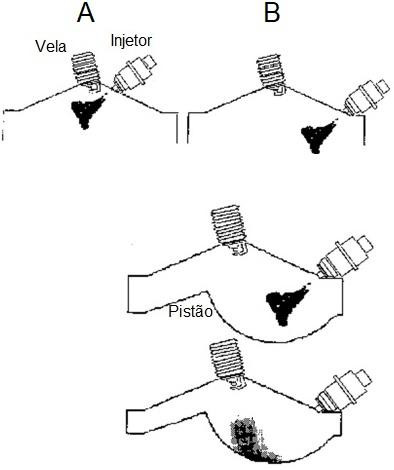Automobile manufacturers are increasingly focusing on engines that use gasoline direct injection systems. This article will focus on these systems. If you want to learn more about previous fuel delivery systems, see the first part of "Gasoline Injection Systems."
In the early versions of the direct injection system (1950 to 1980), injection occurred very early, still during the intake cycle to achieve good fuel atomization, which made achieving the desired fuel economy impossible. The engines operated with homogeneous charge.
In order to save fuel, the basic operation of the system was changed. It started operating with a lean mixture and stratified charge. The spark plug was moved closer to the injection nozzle, and the intake throttle was removed from the system.
The early direct injection systems used had several limitations, making it difficult to justify their use over carburetors or indirect injection systems. The main disadvantages of the system were as follows:
High hydrocarbon emissions;
Reduced optimal operating range, good fuel atomization depended on the engine speed range, and good atomization was only possible at medium and high speeds;
Low efficiency, due to various factors such as early injection timing (still during the intake phase) and operation in stratified charge permanently and with a lean mixture to limit the number of emitted particles. Stoichiometric or rich mixtures were not used.
After 1990, the development of electronically controlled systems and the great need to reduce fuel consumption and pollutant emissions, particularly CO2, drove a significant development in direct injection systems, leading to large-scale production. The systems continue to operate without a throttle valve in the intake manifold and mostly with lean A/F mixtures, but under high load conditions, they switch to stoichiometric mixtures, resulting in a significant increase in power. Atomization is no longer exclusively related to engine speed, injector orifice and piston head geometry are optimized to promote it, and the compression ratio increases.
Gasoline direct injection systems can have three main classifications:
Spray-guided, fuel distribution in the combustion chamber depends mainly on the jet geometry;
Wall-guided, piston geometry promotes fuel distribution in the cylinder;
Air-guided, a combination of the two previous classifications – Fuel is distributed in the cylinder through piston geometry and injector jet position and geometry.
The injector has been moved away from the spark plug, and the spray is no longer directed directly at it (Spray-guided), but rather into a cavity in the piston (Wall-guided), which helps distribute the mixture throughout the cylinder. This change is schematically represented in Figure 1.

Figure 1 - Carburetor working principle
By analyzing Figure 1, it can be seen that in the early "A" systems, the injector was close to the spark plug, and the jet was directed at it. This configuration allowed for stratified charge operation; however, the mixture at the spark plug was very rich, and the fuel did not have time to evaporate, resulting in a higher amount of solid soot particles emissions, which not only were pollutants but also deposited on the spark plug and promoted ignition system failure.
Configuration "B" allows for better fuel vaporization, eliminating the problem of previous systems.
Currently, the main distribution mode of the mixture is Spray-guided and Air-guided, aiming to minimize the contact of the fuel in the liquid phase with the cylinder and piston walls as much as possible to prevent the formation of undesirable rich mixture zones.
The complexity of the systems is increasing to comply with environmental regulations, and each manufacturer may choose a different approach, so it is not possible to address all the parameters that influence the performance and operation of gasoline direct injection systems in this article. Next, a system that represents the level of complexity that can be found in current vehicles to reduce pollutant emissions will be presented.
In Figure 2, a real diagram of a current direct injection system is presented.

Figure 2 - Real injection system
As can be seen from the analysis of Figure 2, these systems can be quite complex. The fuel supply pump has a dedicated control module, and the high-pressure pump has to supply two injection sets that operate at different pressures, in this system, the maximum pressure is 200 bar.
Despite the system having 8 injectors, this is a system of a vehicle with 4 cylinders.

Figure 3 - Direct and indirect injection system
As shown in Figure 3, this system uses a set of injectors for indirect injection and another set for direct injection. Each of the sets can operate individually or simultaneously, depending on the vehicle's operating condition.
The main reason why this system was developed was to reduce the emission of solid particles. Even in current systems, gasoline direct injection, due to its inferior atomization compared to indirect gasoline injection systems, produced up to 10 times more particles than current diesel vehicles. In addition to this advantage, this is a quieter system because indirect injection produces less noise than direct injection. The use of both types of injection allows compliance with EURO 6 standards without the need for a particulate filter, reduces CO2 emissions, and increases engine energy efficiency under partial load conditions and transient regimes.
Indirect Injection – Low Pressure
It is achieved through the same high-pressure pump, two different pressure levels through a bypass in the high-pressure pump. This bypass has a restrictor and sends fuel to the low-pressure rail, monitored by a dedicated pressure sensor and controlled the amount of fuel going to the indirect injection injectors by a pressure valve.
Direct Injection – High Pressure
The high-pressure circuit is used for direct injection. Like the low-pressure circuit, it also has a pressure sensor that
Funcionamento do sistema
O mapa da injeção do motor é dinâmico, o tipo de injeção utilizado depende da condição de funcionamento da viatura. O mapa de injeção é otimizado de forma a reduzir as emissões de poluentes, conservar a qualidade do óleo e reduzir a detonação. Como tal, a mistura A/F, ponto e duração de injeção são constantemente adaptados. O sistema tenta funcionar com mistura estequiométrica (λ=1), sempre que possível.
O mapa de injeção, é apresentado na Figura 4 e é possível concluir o seguinte:
Reduced engine load: the engine operates with indirect injection;
Medium and high engine load: the engine operates with homogeneous mixture and stratified load with direct injection - One injection is performed in the intake phase of the engine and another injection in the compression phase;
Medium load and high engine speed: the engine operates with homogeneous mixture - Only one injection is performed in the intake phase of the engine.
In summary, this is the normal operation of the engine regarding the type of injection used. Additionally, there are some specific operating modes such as:
Cold operation: When the coolant temperature is below 45ºC, the engine always operates with direct injection.
Engine start: Direct injection is performed during the intake and compression phase. The ignition timing is reduced.
Heating/Catalyst heating: Direct injection is performed during the intake and compression phase. The ignition timing is reduced.
Safety mode (fuel overheating): During prolonged operation periods with indirect injection, the fuel may overheat. To avoid this situation, direct injection can be used alternately for short periods of time.
Redundancy: If one of the injection systems fails or malfunctions, the other system takes over.

Figure 4 - Injection Map
This is just an example of the various systems that can exist within gasoline direct injection systems, as mentioned earlier, the complexity and operation of the system will vary depending on the manufacturer's approach.
LD Auto would like to emphasize the need for interventions in these types of vehicles to be carried out by competent technicians with training in the field, only with these skills is it possible to understand the operation of these systems and intervene in them effectively.












